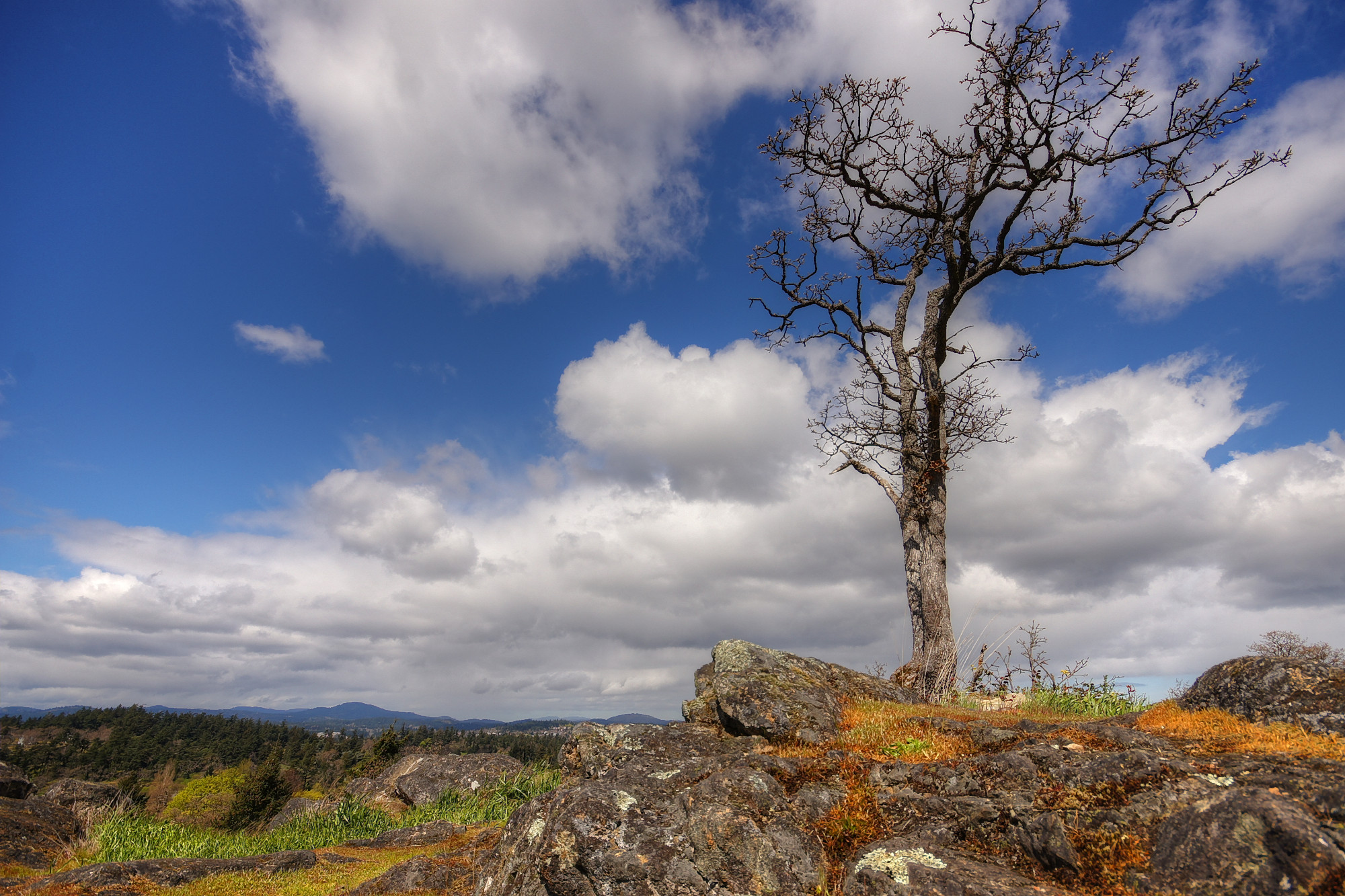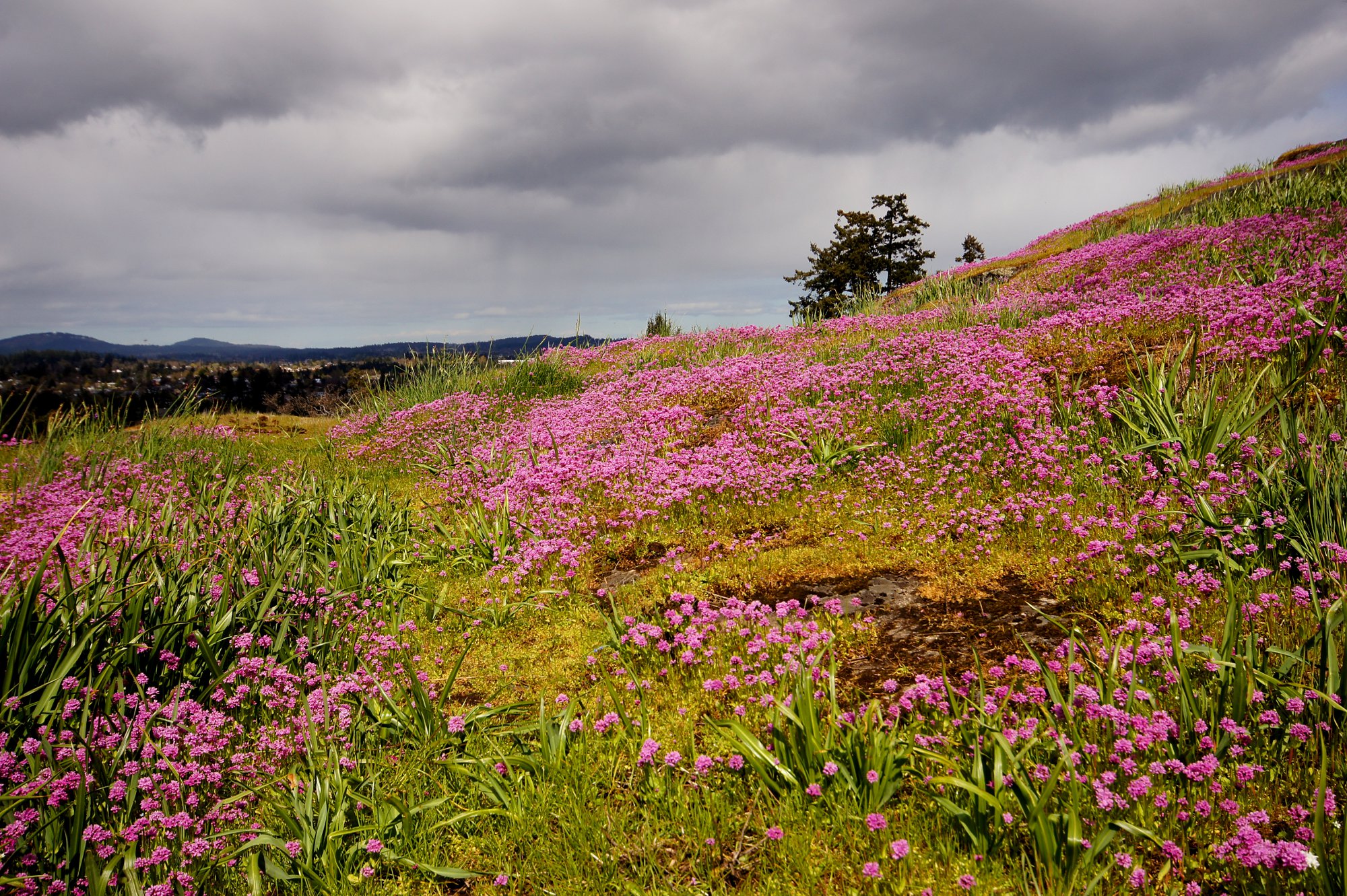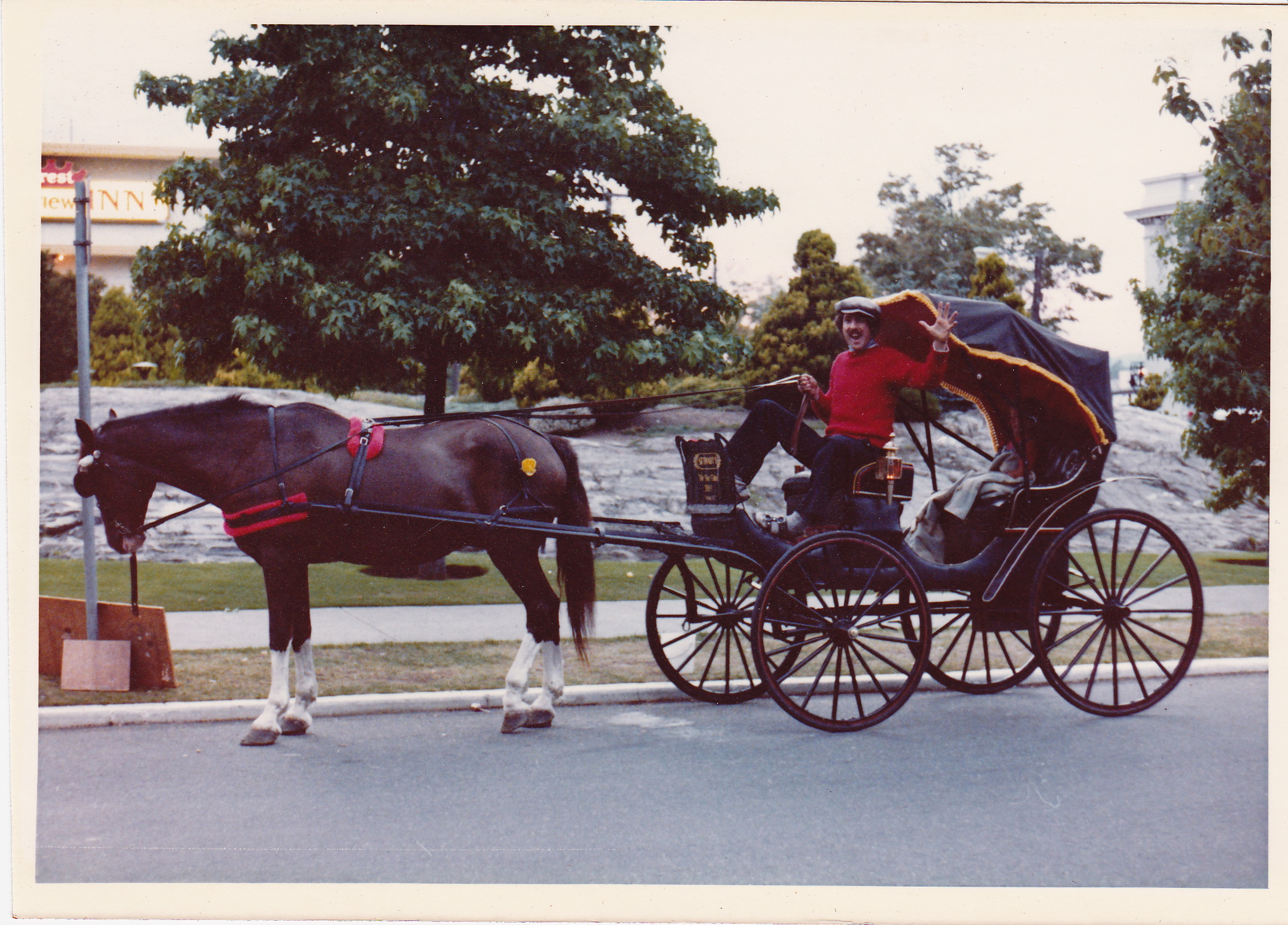While in Goldstream Park last week I noticed this little wildflower that I had not identified previously. It is called Hooker's Fairy-bell (Prosartes hookeri), named after Joseph Hooker, a renowned botanist. Those little white flowers turn into bright red berries when they mature.

Tuesday, April 30, 2013
Hooker's Fairy-bell (Prosartes hookeri)
Monday, April 29, 2013
Goldstream Park
Most of the wildflowers I've been photographing lately are found in conjunction with the Garry Oak Ecosystem. Last week Fern and I went out to another eco-zone - the temperate rain forest that is found in Goldstream Park. Though not so rich in spring wildflowers as the sunnier and more open Garry Oak locations our rain forest is also full of burgeoning growth at this time of year. Above, a beam of sunlight catches the mosses and young leaves on some Bigleaf Maple trees.
Sunday, April 28, 2013
Beauty Is In the Eye of the Beholder
Saturday, April 27, 2013
Death Camas (Toxicoscordion venenosum)
This plant is called Death Camas (Toxicoscordion venenosum), not because it is a related to the Camas Lilies posted yesterday but because its bulbs are very similar to Camas bulbs, with one important difference - the bulbs of Death Camas are very poisonous. While the flowers of this plant and Camas Lilies are quite different, traditionally the bulbs were not harvested until long after the flowering season when even the leaves had withered. Death Camas often grow in close proximity to Camas Lilies and the bulbs of both could be harvested together, with dire consequences. During the flowering season, when the two plants could be easily distinguished, First Nations people would industriously uproot the Death Camas from their favored Camas Lily meadows. However, without that kind of care, harvesting Camas Bulbs in late summer is probably a foolish activity. Better nowadays simply to enjoy the splendid flowers. The Death Camas pictured above was photographed in Bear Hill Park on the Saanich Peninsula.
Friday, April 26, 2013
Camas Lilies (Camas quamash)
| Many wildflowers grow in great numbers here during the spring but none of them in such profusion as these splendid Camas Lilies (Camas quamash). They are no longer classified as members of the lily family but many people continue to refer to them as lilies. The bulbs of this plant were an important food source for First Nations people over wide areas of North America. The bulbs were not gathered until late summer. Some were roasted and eaten but they could also be dried and ground into a kind of flour. |
Thursday, April 25, 2013
Luck
On a recent morning walk along the West Bay Walkway I noticed that there were several Great Blue Herons (Ardea herodias) stalking their breakfast so I stopped, attached the 300mm telephoto lens and made the settings appropriate for capturing photos of birds in flight, on the off chance one of the herons might decide to change locations. As luck would have it, a few minutes later this splendid specimen spread his wings and flew across my field of vision exactly where I had imagined. Sometimes you don't get what you want, and sometimes you have to struggle to get it, but there are times when it just falls into your lap.
Wednesday, April 24, 2013
Elusive Orchid
I am pleased to introduce the Fairy Slipper (Calypso bulbosa) to these pages. I have been looking for this elusive indigenous wild orchid for several years now and was finally able to enjoy some on my recent excursion to Bear Hill Park in Saanich. They are very small and inconspicuous and tend to grow in shady hidden areas on the forest floor, never very profusely. Although I saw about a dozen altogether, I never saw more than three in a group. They are only found in conjunction with a specific kind of fungus and the tiny seeds will not germinate if the fungus is not present. Nor will the plant survive if transplanted to an area without that specific fungus, so if you should be lucky enough to see one, leave it undisturbed
Tuesday, April 23, 2013
Bear Hill Park
Bear Hill Park is on the Saanich Peninsula about a half hour's drive from Victoria and is covered with spring flowers right now, especially Shooting Stars, Sea Blush, Camas and Fawn Lilies. But what I really went there for a few days ago was to see if I could find one of our local wild orchids, commonly called Ladyslipper (Calypso bulbosa). I was lucky enough to find a few and will share a photo tomorrow. For today let's just enjoy the view from near the summit of Bear Hill. Below, take a minute and watch the clouds sail by.
Monday, April 22, 2013
Sunday, April 21, 2013
Rainy Day Bus Ride

On days when the rain is coming at you sideways because of the wind, when the bus pulls up to the curb it is with great relief you climb aboard. Haven't we all been here on a cross town bus at some time in our lives? - Fern
Saturday, April 20, 2013
The Inner Harbour Looking Out
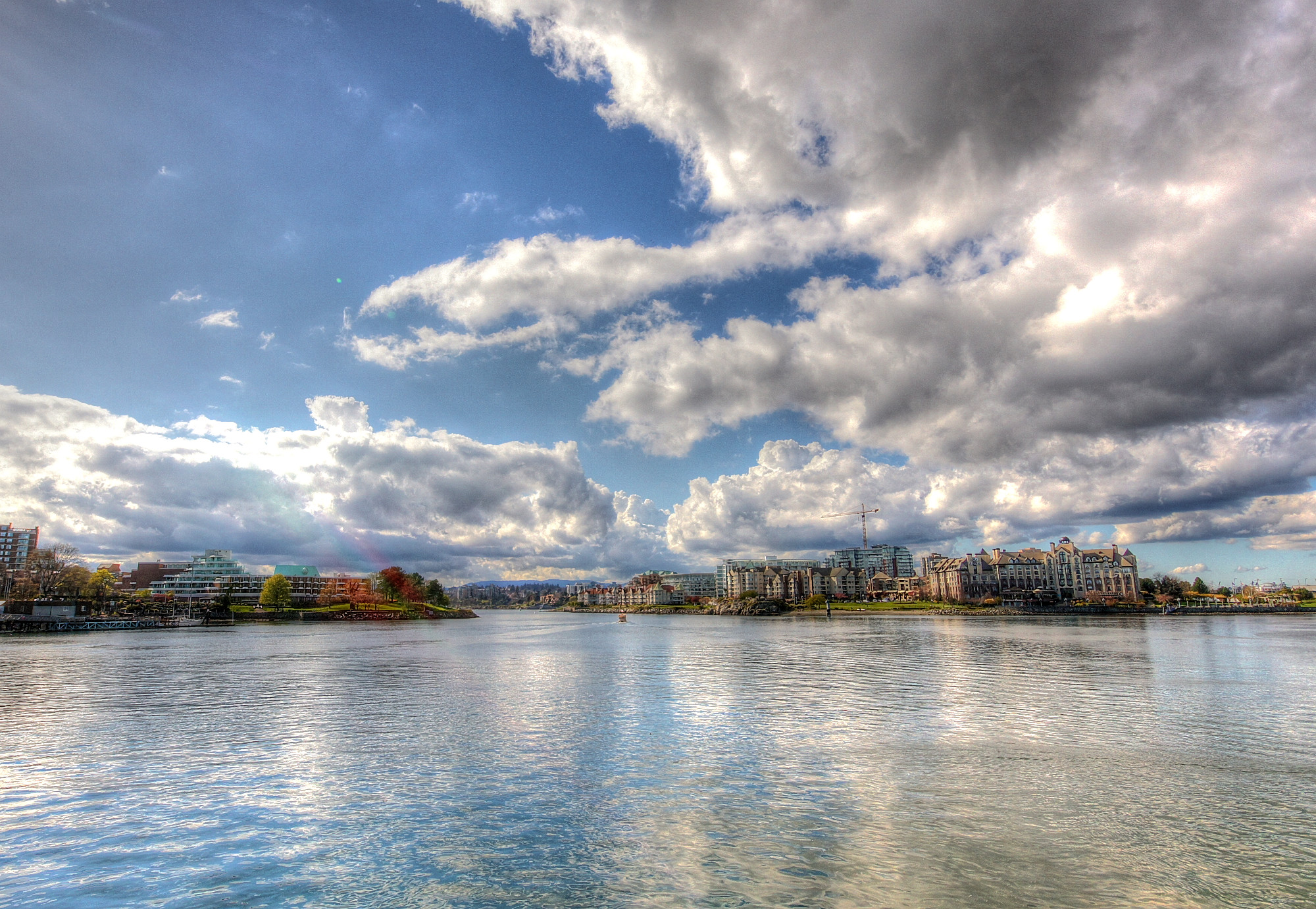 This is the view from Ship Point looking at the entrance to the Inner Harbour between Laurel Point (on the left) and Songhees Point (on the right). The Causeway, the Empress Hotel, and Legislative Assembly Building are behind us in this photo. Lately we've been having blustery weather that produces these big clouds and clear air.
This is the view from Ship Point looking at the entrance to the Inner Harbour between Laurel Point (on the left) and Songhees Point (on the right). The Causeway, the Empress Hotel, and Legislative Assembly Building are behind us in this photo. Lately we've been having blustery weather that produces these big clouds and clear air.
Friday, April 19, 2013
Highrock Park 2
Only a few steps away from the site of yesterday's photo lies this lush environment. Add to this wonderful diversity of landscape a wealth of wildflowers and you have the recipe for a perfect park.
Thursday, April 18, 2013
Highrock Park 1
Wednesday, April 17, 2013
Cormorant Plumage
A few weeks ago I posted some photos of Pelagic Cormorants that we saw on a trip to the Gulf Islands and I remarked on their plumage as more beautiful than the Double-crested cormorants I normally see near Victoria. However, on a recent visit to Thetis Lake Park I was able to take some more close-up photos of a Double-crested Cormorant and as you can see in the above photo, they too have beautiful markings when seen from close up. A little more distance and those splendid dappled feathers simply look black. Also I was pleased to see that the Double-crested Cormorants share those remarkable jade green eyes that so struck me when I first saw the Pelagic Cormorants. While it's good to get up close to see details of these birds, I like to see photos like those posted recently on Mike Laplante's blog "tales from a pale blue dot", that have a wonderful atmosphere. Mike's photo of cormorants in the morning mist over Swan Lake is a wonderfully evocative, timeless scene.
Tuesday, April 16, 2013
Sea Blush (Plectritis congesta)
 | Highrock Park in Vic West is lovely at any time of year but is outstanding in the spring. The magnificent carpet of Sea Blush (Plectritis congesta) pictured above is only one reason and I'll post a few more photos later this week to show some others. Following sharp on the heels of the blooming Sea Blush will be the Camas Lilies and their rich blue-purple will provide the perfect counterpoint to this vibrant pink. Most of the taller grass-like leaves visible in the foreground of the above photo are Camas and they will probably bloom en masse next week. To the left is a close-up of a Sea Blush plant. They are quite small, little more than ankle-height in Highrock Park, but more than make up for their diminutive size with their lavish profusion. |
Monday, April 15, 2013
More of Rithet's Bog
Springtime offers such a lovely contrast between winter's bare branches and the first brilliant greens of the coming summer. - Fern
Sunday, April 14, 2013
Rithet's Bog
In a brief window of mild spring sunshine this week Benjamin Madison and I went for a lovely stroll around Rithet's Bog in Saanich. There is a huge variety of wildlife and several distinct ecosystems. I have a special love of the bulrushes, as you can see. - Fern
Saturday, April 13, 2013
The Big Picture
One of the reasons I focus so much on individual plants and flowers when I'm out in our local parks is because it is very difficult to capture the the majesty and grandeur of our West Coast temperate rain forests. One wanders like a midget among trees so tall that their tops are nearly invisible. With this photo I like the way the long shadows suggest the height and primeval age of these trees in Thetis Lake Park.
Friday, April 12, 2013
Tourist Town
Thursday, April 11, 2013
Red Crossbills (Loxia curvirostra)
Regular visitors here will know that I am never so happy as when I can add a new species of wildlife or wildflower to my collection so you will know that last week was a red-letter week when I visited the summit of Mount Douglas and had my first sighting of these wonderfully coloured birds. Here is a whole flock of Red Crossbills (Loxia curvirostra). They are shaped and move quite like small parrots or parakeets and their bright red colour also suggests some tropical species. Additionally they have an unusual beak where the top and bottom mandibles cross over one another, giving rise to their name. This unusual bill allows them to feed on the seeds hidden within pine cones, their favoured food. The bright orange-red shade is only characteristic of the males. If you look carefully at both photos you will also see females of the species who are an olive-yellow shade.
Wednesday, April 10, 2013
Trillium (Trillium ovatum)
Here's another of our earliest blooming wildflowers, Trillium (Trillium ovatum). It's the emblem and official flower of the Canadian province of Ontario and one of my favourite spring wildflowers. These were photographed in Mount Douglas Park last week. While I understand they grow in great profusion in some places, here I seldom see more than two or three plants together. The blooms of this particular species change colour as they age, from white to pink to maroon.
Tuesday, April 9, 2013
Ross Bay Cemetery 2 - Kenneth Mackenzie (1811-1875)
Above is the family mausoleum of Kenneth MacKenzie, his wife Agnes and other members of their family. It is located right next to the plot of the Pearse family that I posted about last Wednesday. There is something very Scottish about the craggy solidity of this structure - and that is fitting for a Scotsman who came out from Scotland to carve out a new life for himself and his family in early Victoria.
 | The foundation of his house, now known as Craigflower Manor, had been laid before his arrival in Victoria but the building (on the left) was completed after he came according to his wishes to have it resemble his family home, Renton Hall, in Scotland. Renton Hall is pictured on the right (Photo from virtualmuseum.ca.) Craigflower Manor still stands although since a serious fire some years ago it remains closed to the public. Nevertheless there is an excellent website where one can get a good idea of the furnishings and interior of the house and the kind of life the MacKenzies lived there. Click HERE to visit Craigflower Manor website. | 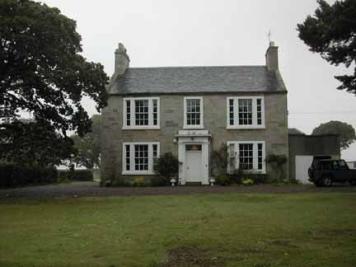 |
Monday, April 8, 2013
The View From Mt. Tolmie

The look out on top of this small mountain (elevation 120 meters) is quite popular all year round and maybe even more so when the weather is wild like it has been lately. - Fern
Sunday, April 7, 2013
The Truth About Victoria

How in the world do you follow up a photo like yesterdays? Such a magnificent shot. So here it is, my vision of Victoria at this time of year. - Fern
Saturday, April 6, 2013
Mount Douglas Carpeted with Giant White Fawn Lilies
To continue recapping my spring wildflower posts, here are a few more Giant White Fawn Lily photos, both taken recently on Mount Douglas. There are dense patches of these splendid wildflowers all over the mountain at this time of year. The photo above gives some idea of this. Below is a photo of the entire plant that shows the beautifully dappled markings that give this little lily its name because of their similarity to the markings on young deer.
Friday, April 5, 2013
Distraction!
 Whenever I get out into the rural setting in the spring I tend to get focused on what's on the ground, those brilliant spring wildflowers such as I posted yesterday. I am also a little impatient of distractions so that earlier this week when I was zeroing in on the Shooting Stars a very loud sort of rusty squeaking kept breaking in on my concentration. Finally I looked up to see what could be making such a noise and there it was, in a nearby tree, a glorious Bald Eagle (Haliaeetus leucocephalus). (Roger Tory Peterson in "A Field Guide to Western Birds" describes their call as "...a harsh, creaking cackle....") When I suddenly see something like this there is always a period of frantic activity (remove close-up lens, replace with telephoto lens, adjust ISO and aperture, lengthen tripod legs, etc.). At the same time it all has to be done calmly and quietly so as not to disturb the subject or destroy the equipment. With this eagle I barely got set up when he took off from the branch where he was sitting. But at least he left me this one clear shot to take home. There were actually three Bald Eagles cruising around above the summit of Mount Douglas that day, two of them apparently jousting for the attentions of the third.
Whenever I get out into the rural setting in the spring I tend to get focused on what's on the ground, those brilliant spring wildflowers such as I posted yesterday. I am also a little impatient of distractions so that earlier this week when I was zeroing in on the Shooting Stars a very loud sort of rusty squeaking kept breaking in on my concentration. Finally I looked up to see what could be making such a noise and there it was, in a nearby tree, a glorious Bald Eagle (Haliaeetus leucocephalus). (Roger Tory Peterson in "A Field Guide to Western Birds" describes their call as "...a harsh, creaking cackle....") When I suddenly see something like this there is always a period of frantic activity (remove close-up lens, replace with telephoto lens, adjust ISO and aperture, lengthen tripod legs, etc.). At the same time it all has to be done calmly and quietly so as not to disturb the subject or destroy the equipment. With this eagle I barely got set up when he took off from the branch where he was sitting. But at least he left me this one clear shot to take home. There were actually three Bald Eagles cruising around above the summit of Mount Douglas that day, two of them apparently jousting for the attentions of the third.
Thursday, April 4, 2013
Spring Wildflowers Recap
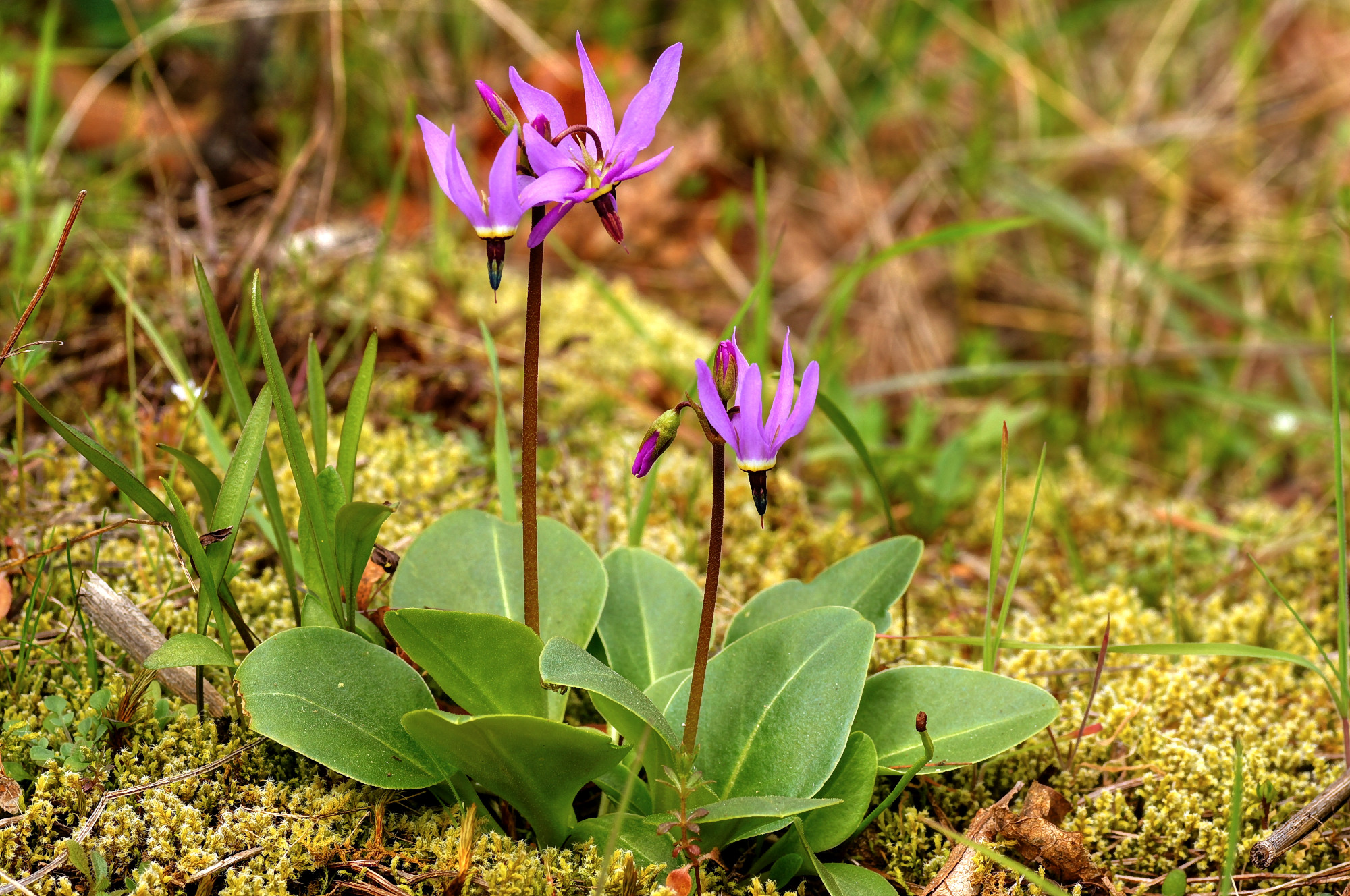 I am always so happy to see spring wildflowers arrive that I often post the earliest photos I take rather than the best. So, here is a bit of a revisiting of some of this spring's early photos. Above are some Shooting Stars (Dodecatheon hendersonii). This photo was taken near the summit of Mount Douglas and the Shooting Stars blooming there grow surrounded by low groundcover like moss. This makes the basal leaves much more visible so it is possible to get a good picture of the whole plant rather than just the flower. Below is a Satinflower (Olsynium douglasii). Generally the blooms on these are so close to the ground and droop downwards so much that it is impossible to see the inside of the flower. This one is lifted just enough to enable a good view of the interior. Also, the entire plant is visible.
I am always so happy to see spring wildflowers arrive that I often post the earliest photos I take rather than the best. So, here is a bit of a revisiting of some of this spring's early photos. Above are some Shooting Stars (Dodecatheon hendersonii). This photo was taken near the summit of Mount Douglas and the Shooting Stars blooming there grow surrounded by low groundcover like moss. This makes the basal leaves much more visible so it is possible to get a good picture of the whole plant rather than just the flower. Below is a Satinflower (Olsynium douglasii). Generally the blooms on these are so close to the ground and droop downwards so much that it is impossible to see the inside of the flower. This one is lifted just enough to enable a good view of the interior. Also, the entire plant is visible.Finally, earlier this year I posted an early photo of a Grape Hyacinth (genus Muscari) in bud. Below you can see what they are like now in glorious profusion. These (and the Satinflower above) were photographed in Highrock Park here in Vic West.
Wednesday, April 3, 2013
Ross Bay Cemetery - Mary Laetitia Pearse (1840-1872)
| Friday's balmy weather stretched right through the long weekend and I took advantage of it to begin a project - getting to know the Ross Bay Cemetery. It's the oldest cemetery in Victoria and walking around in it is like taking a stroll through Victoria's history. I have a copy of the "Historic Guide to Ross Bay Cemetery" by John Adams that contains 13 tours of sections of the cemetery. I started with tour number one which, appropriately, begins with the oldest grave, a burial that took place in 1872, several months before the cemetery was officially opened in 1873. In the above photo it is the grave on the right. This is the same grave that was photographed in 1874 in the photo to the left. It is the grave of Mary Laetitia Pearse (1840-1872), the first wife of Benjamin William Pearse (1832-1902), who is also buried in this plot. His grave is marked by a simple stone between his first and second wives' gravestones. The inscription reads "Benjamin William Pearse of Fernwood". Fernwood at that time was not a neighbourhood; it was the name of Pearse's home, Fernwood Manor, from which the neighbourhood got its name. Pearse came to Victoria in 1851 and in 1864 became Surveyor-General of Vancouver Island. His second wife, Sarah Jane Pearse continued to live in Fernwood Manor after her husband's death in 1902. She died, aged 100, in 1954 and the house was demolished in 1969. Some of the foregoing information and the photo at the left were taken from John Adams' "Historic Guide to Ross Bay Cemetery" and some was derived from the Wikipedia entry on the Fernwood Neighbourhood. The photo on the left is originally from the Provincial Archives of BC - PABC 6808. |
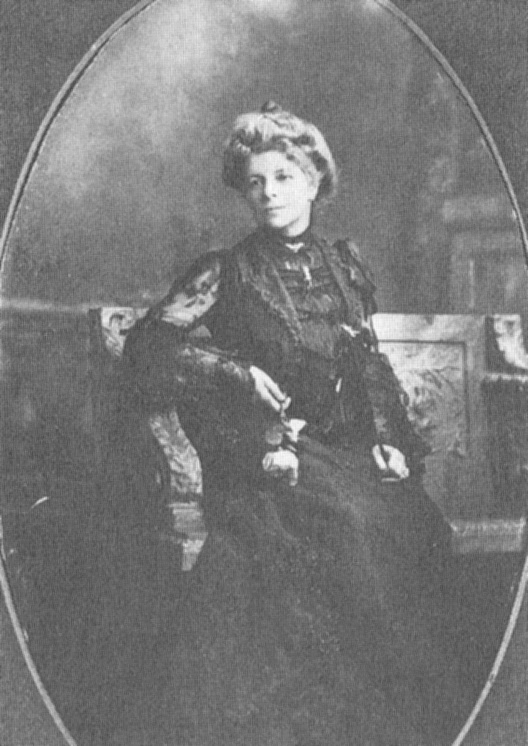 | 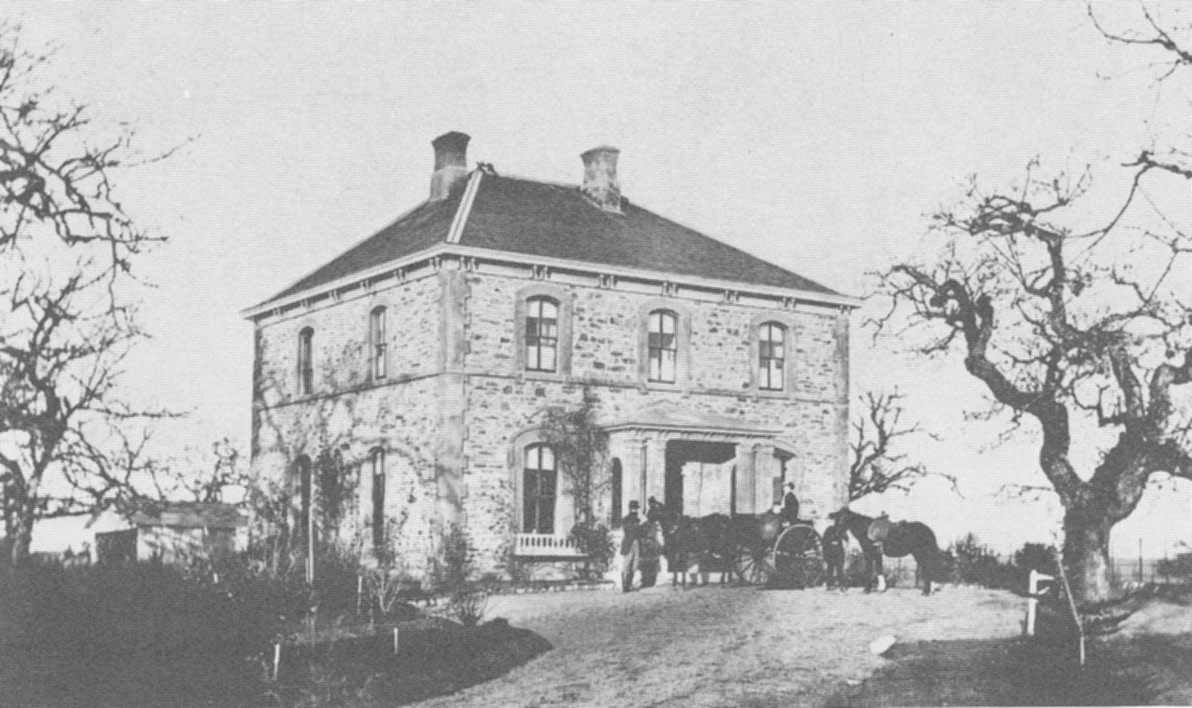 |
Tuesday, April 2, 2013
Shooting Stars (Dodecatheon hendersonii)
Whenever I head up to Highrock Park in the early spring some of the first wildflowers I look for are these Shooting Stars (Dodecatheon hendersonii). They come up in the same places every year. Recently when I checked their usual locations, none of them were visible yet but just as I was about to leave the park I spotted their lovely magenta/purple flowers in the grass near the path.
Monday, April 1, 2013
Fort Street

I had a moment to stop and contemplate the empty streets of Victoria on a weekend morning, discovering a delightful sense of expectation. - Fern

